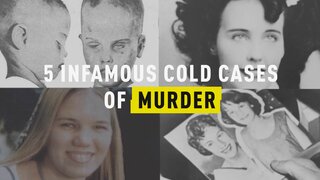Create a free profile to get unlimited access to exclusive videos, breaking news, sweepstakes, and more!
Murder Suspect's Body Exhumed To Solve Two 1990s Cold Cases
The family of one murder victim told police that "words alone cannot expres our appreciation" after a link to suspect Robert Brashers was made almost three decades later.
A man linked to several cold-case murders, including the 1998 murder of a mother and her 12-year-old daughter, has been identified by police through the use of advanced DNA testing.
Police have connected Robert Eugene Brashers to three unsolved murders, the unsolved sexual assault of a 14-year-old girl and the unsolved shooting of a young mother, who survived the attack.
Brashers died in 1999 by a self-inflicted gunshot wound during a standoff with police outside of a motel, but it wasn't until this month that officials announced Brashers is the lead suspect in a string of cold-case crimes across the south and Missouri after his DNA was found to be a match to evidence found at all of the crime scenes.
The crimes began on April 4, 1990 with the brutal rape and murder of Greenville, South Carolina resident Genevieve (Jenny) Zitricki, 28.
"An intruder entered her apartment by prying open the sliding glass door. He attacked her as she slept, bludgeoned her, strangled her and sexually assaulted her," Greenville Police Department Chief Ken Miller said during a press conference announcing the suspect in the case.
Her body was found two days later in the bathtub, with the water running, after Zitricki (pictured above) —who Miller described as young, active and "often the life of the party"— failed to show up for work.
Police found a "threatening message" on her mirror, according to a press release announcing the developments in the case.
It was a case that plagued law enforcement officers for years, but after months turned into years without any significant leads in the murder, the case went cold.
In 2005, Miller said police sent evidence from the crime scene to the South Carolina Law Enforcement Division's DNA lab to create a DNA profile. A year later, the DNA found at the scene was linked to another brutal murder in Missouri but it wouldn't be until July of 2018 that investigators from multiple agencies would seek out the help out Parabon NanoLabs, a DNA-technology company that specializes in "genetic genealogy" or the process of using DNA testing in combination with genetic analysis to determine a person's relationship to his or her ancestors.
In August, investigators were able to use "genealogical, genetic, and circumstantial evidence," to conclude that it Brashers was a "highly likely" suspect, Miller said during the press conference.
After DNA from his family matched with the samples, law enforcement investigators exhumed Brashers' body in September and were able to "conclusively match" his DNA to the evidence found at multiple crime scenes, fully revealing the true extent of Brashers' alleged crimes.
"We know now that Robert Brashers was a violent serial rapist and murderer," Miller said.
Investigators now believe after killing Zitricki in 1990, he'd go on to allegedly sexually assault a 14-year-old female in Memphis, Tenn., in 1997, just one month after being released from prison for possession of a stolen weapon and vehicle.
A year later, police said Brashers allegedly brutally killed Sherri Scherer and her 12-year-old daughter Megan in Portageville, MO.
"He shot them multiple times," Miller said. "Megan was also sexually assaulted."
That same day police say he tried to force his way into a home in Dyersburg, Tenn., where a young mother was at home with a small child.
The woman, 25, fought with the intruder and was shot during the altercation, but survived and was later able to provide a description to police.
Miller said the projectile retrieved from her body was later also determined to be match to the Scherer murders.
On April 12, 1998 Brashers was arrested in Paragould, Ark., trying to break into a single woman's home where he had previously done some handy work. Miller said he had cut the phone lines and had a firearm, video camera and other tools in his possession at the time of his arrest, but he was released from custody the following day.
His final run-in with police came on January 13, 1999 after police noticed a vehicle with a stolen tag in the parking lot of a Super 8 Motel in Kennett, Mo.
They were able to track the vehicle to a motel room where they found Brashers with his wife and children. He was hiding under the bed and was armed.
After a four hour standoff with police, Brashers released his wife and children and then shot himself, police said. He died six days later on January 19, 1999.
Through the use of advanced DNA technology, police were able to link Brasher to the previously unsolved crimes and bring the victims' family a degree of justice.
"Today is a bittersweet moment in that we have finally been able to bring closure to the family of Jenny Zitricki," Miller said, adding that several investigators in the case had even returned to work on the case after they had retired.
Her brother, Phillip Zitricki, also spoke during the press conference and thanked the investigators who never gave up or "forgot their promise."
"We thank you for your persistence, your teamwork and your zeal to succeed," he said. "You have traveled a long road and reached the goal. Words alone cannot express our appreciation."
He described his sister as a "force of nature, a firecracker, a bundle of infectious energy," and said he hoped she is remembered "not as she left but as she lived."
[Photos: Greenville Police Department]






























